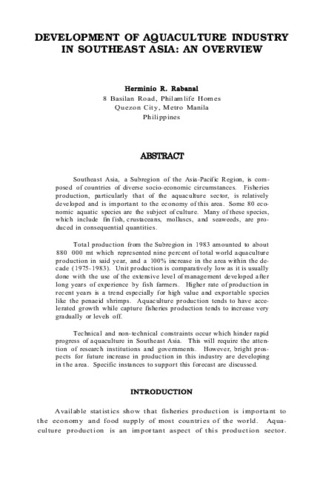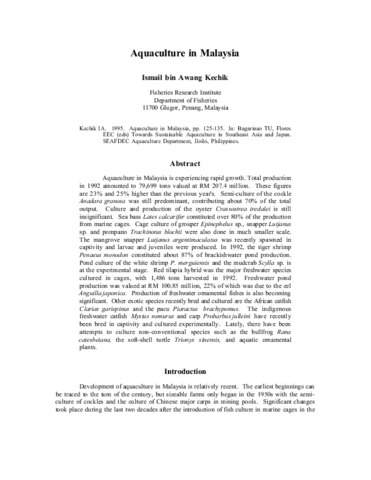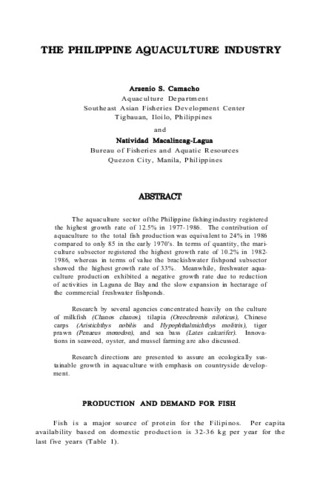Development of aquaculture industry in Southeast Asia: An overview
- Global styles
- MLA
- Vancouver
- Elsevier - Harvard
- APA
- Help
Share
Abstract
Southeast Asia, a Subregion of the Asia-Pacific Region, is composed of countries of diverse socio-economic circumstances. Fisheries production, particularly that of the aquaculture sector, is relatively developed and is important to the economy of this area. Some 80 economic aquatic species are the subject of culture. Many of these species, which include fin fish, crustaceans, molluscs, and seaweeds, are produced in consequential quantities.
Total production from the Subregion in 1983 amounted to about 880 000 mt which represented nine percent of total world aquaculture production in said year, and a 100% increase in the area within the decade (1975-1983). Unit production is comparatively low as it is usually done with the use of the extensive level of management developed after long years of experience by fish farmers. Higher rate of production in recent years is a trend especially for high value and exportable species like the penaeid shrimps. Aquaculture production tends to have accelerated growth while capture fisheries production tends to increase very gradually or levels off.
Technical and non-technical constraints occur which hinder rapid progress of aquaculture in Southeast Asia. This will require the attention of research institutions and governments. However, bright prospects for future increase in production in this industry are developing in the area. Specific instances to support this forecast are discussed.
Suggested Citation
Rabanal, H. R. (1988). Development of aquaculture industry in Southeast Asia: An overview. In J. V. Juario & L. V. Benitez (Eds.), Perspectives in Aquaculture Development in Southeast Asia and Japan: Contributions of the SEAFDEC Aquaculture Department. Proceedings of the Seminar on Aquaculture Development in Southeast Asia, 8-12 September 1987, Iloilo City, Philippines. (pp. 3-37). Tigbauan, Iloilo, Philippines: SEAFDEC, Aquaculture Department.
Type
Conference paperISBN
971851113XCollections
- ADSEA '87 [20]
Related items
Showing items related by title, author, creator and subject.
-
Aquaculture in Malaysia
Kechik, Ismail bin Awang. (Aquaculture Department, Southeast Asian Fisheries Development Center, 1995)Aquaculture in Malaysia is experiencing rapid growth. Total production in 1992 amounted to 79,699 tons valued at RM 207.4 million. These figures are 23% and 25% higher than the previous year's. Semi-culture of the cockle ... -
Aquaculture development in Thailand
Sirikul, Boonsong; Luanprida, Somsak; Chaiyakam, Kanit; Sriprasert, Revadee (Aquaculture Department, Southeast Asian Fisheries Development Center, 1988)Aquaculture practised in Thailand is in the form of pond culture and cage culture in freshwater, brackishwater and coastal areas. The main species cultured include freshwater prawns, brackishwater shrimp, cockles, mussels, ... -
The Philippine aquaculture industry
Camacho, Arsenio S.; Macalincag-Lagua, Natividad (Aquaculture Department, Southeast Asian Fisheries Development Center, 1988)The aquaculture sector of the Philippine fishing industry registered the highest growth rate of 12.5% in 1977-1986. The contribution of aquaculture to the total fish production was equivalent to 24% in 1986 compared to ...






